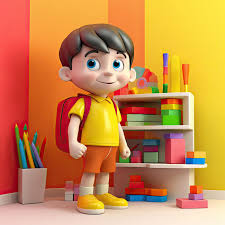In today’s evolving educational landscape, the role of a teacher extends far beyond traditional classroom instruction. Modern educators increasingly recognize the value of incorporating various media forms into their teaching methods, particularly kids animated shows that can reinforce learning objectives while engaging young minds through colorful characters and compelling narratives. This symbiotic relationship between formal education and animated content creates a powerful learning environment where children can absorb information through multiple channels.
The integration of animated content into teaching strategies represents a significant shift in educational philosophy. Many teachers now curate specific animated series that align with curriculum goals, creating lesson plans that reference familiar characters or scenarios from these programs. This approach acknowledges the reality that children today are digital natives, and leveraging their natural interest in animated content can significantly enhance educational outcomes. Rather than viewing screen time as competition for attention, forward-thinking educators are harnessing its potential as a complementary teaching tool.
The psychological impact of animated characters on young learners cannot be overstated. Children often form emotional connections with animated protagonists, viewing them as trusted friends whose experiences and lessons carry substantial weight. This phenomenon creates a unique opportunity for educational reinforcement, as concepts introduced in the classroom can be echoed and amplified through animated adventures. The consistency between messages delivered by authority figures in real life and beloved characters in animated worlds provides children with a coherent educational narrative.
Animated shows designed with educational intent often incorporate subtle learning elements within entertaining storylines. Mathematics concepts appear as characters solve problems, scientific principles emerge through adventure plots, and social-emotional skills develop as animated friends navigate relationships. These educational layers may be processed subconsciously by young viewers who primarily engage with the entertainment value, yet the learning occurs organically alongside enjoyment.
The accessibility of animated content represents another significant advantage for educational purposes. While classroom instruction follows specific schedules, animated educational content can be revisited repeatedly, allowing children to engage with challenging concepts at their own pace. This repetition reinforces learning in ways that single classroom presentations cannot achieve, particularly for visual learners who benefit from the graphic representations inherent in animation.
Cultural diversity and representation in modern animated shows provide another valuable educational dimension. Through thoughtfully designed animated characters and scenarios, children encounter different perspectives, traditions, and experiences that might otherwise remain abstract concepts. This exposure fosters empathy and global awareness from an early age, complementing diversity education initiatives within school settings.
The pandemic era dramatically highlighted the educational potential of quality animated content when traditional classroom settings became temporarily inaccessible. Many teachers quickly adapted by recommending specific animated programs that aligned with curriculum goals, guiding parents toward educational content that could supplement remote learning efforts. This period accelerated the integration of animated media into formal educational strategies, breaking down previous barriers between entertainment and instruction.
Parents who partner with teachers in educational efforts often report that referencing animated characters and scenarios helps reinforce classroom concepts at home. When children recognize that the values and information presented by trusted adults align with messages from favorite animated shows, the educational impact strengthens through consistent reinforcement across different environments.
The production quality of educational animated content has improved dramatically in recent decades, with child development experts and educators often consulting on content creation. This collaboration ensures that animated programs designed for children contain age-appropriate challenges, accurate information, and positive social messaging that supports rather than contradicts classroom teaching.
Forward-thinking teacher training programs now include media literacy components that prepare educators to effectively incorporate animated content into lesson plans. This preparation acknowledges that modern teaching requires familiarity with the media landscape that shapes children’s understanding of the world, including the ability to critically evaluate and selectively utilize animated programs that align with educational objectives.
The future of education likely involves even greater integration between traditional teaching methods and thoughtfully produced animated content. As technology advances and content creators increasingly prioritize educational value alongside entertainment, the line between learning and play continues to blur in ways that benefit children’s holistic development. Teachers who embrace this evolution position themselves as guides who can help children navigate both real and animated worlds with curiosity and critical thinking skills.

